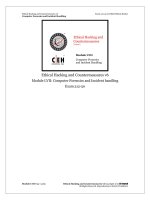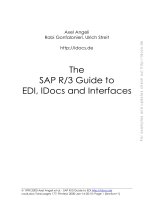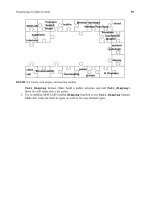Guide to Computer forensics and investigations Chapter 4 Processing crime and incident scenes
Bạn đang xem bản rút gọn của tài liệu. Xem và tải ngay bản đầy đủ của tài liệu tại đây (339.32 KB, 71 trang )
Guide to Computer Forensics
and Investigations
Fifth Edition
Chapter 4
Processing Crime and Incident
Scenes
Objectives
• Explain the rules for controlling digital evidence
• Describe how to collect evidence at private-sector
incident scenes
• Explain guidelines for processing law enforcement
crime scenes
• List the steps in preparing for an evidence search
• Describe how to secure a computer incident or
crime scene
Guide to Computer Forensics and Investigations Fifth Edition
© Cengage Learning 2015
2
Objectives
• Explain guidelines for seizing digital evidence at
the scene
• List procedures for storing digital evidence
• Explain how to obtain a digital hash
• Review a case to identify requirements and plan
your investigation
Guide to Computer Forensics and Investigations Fifth Edition
© Cengage Learning 2015
3
Identifying Digital Evidence
• Digital evidence
– Can be any information stored or transmitted in
digital form
• U.S. courts accept digital evidence as physical
evidence
– Digital data is treated as a tangible object
• Groups such as the Scientific Working Group on
Digital Evidence (SWGDE) set standards for
recovering, preserving, and examining digital
evidence
Guide to Computer Forensics and Investigations Fifth Edition
© Cengage Learning 2015
4
Identifying Digital Evidence
• General tasks investigators perform when working
with digital evidence:
– Identify digital information or artifacts that can be
used as evidence
– Collect, preserve, and document evidence
– Analyze, identify, and organize evidence
– Rebuild evidence or repeat a situation to verify that
the results can be reproduced reliably
• Collecting digital devices and processing a criminal
or incident scene must be done systematically
Guide to Computer Forensics and Investigations Fifth Edition
© Cengage Learning 2015
5
Understanding Rules of Evidence
• Consistent practices help verify your work and
enhance your credibility
• Comply with your state’s rules of evidence or with
the Federal Rules of Evidence
• Evidence admitted in a criminal case can be used
in a civil suit, and vice versa
• Keep current on the latest rulings and directives on
collecting, processing, storing, and admitting digital
evidence
Guide to Computer Forensics and Investigations Fifth Edition
© Cengage Learning 2015
6
Understanding Rules of Evidence
• Data you discover from a forensic examination falls
under your state’s rules of evidence
– Or the Federal Rules of Evidence (FRE)
• Digital evidence is unlike other physical evidence
because it can be changed more easily
– The only way to detect these changes is to compare
the original data with a duplicate
• Most federal courts have interpreted computer
records as hearsay evidence
– Hearsay is secondhand or indirect evidence
Guide to Computer Forensics and Investigations Fifth Edition
© Cengage Learning 2015
7
Understanding Rules of Evidence
• Business-record exception
– Allows “records of regularly conducted activity,” such
as business memos, reports, records, or data
compilations
• Generally, digital records are considered
admissible if they qualify as a business record
• Computer records are usually divided into:
– Computer-generated records
– Computer-stored records
Guide to Computer Forensics and Investigations Fifth Edition
© Cengage Learning 2015
8
Understanding Rules of Evidence
• Computer and digitally stored records must be
shown to be authentic and trustworthy
– To be admitted into evidence
• Computer-generated records are considered
authentic if the program that created the output is
functioning correctly
– Usually considered an exception to hearsay rule
• Collecting evidence according to the proper steps
of evidence control helps ensure that the computer
evidence is authentic
Guide to Computer Forensics and Investigations Fifth Edition
© Cengage Learning 2015
9
Understanding Rules of Evidence
• When attorneys challenge digital evidence
– Often they raise the issue of whether computergenerated records were altered or damaged
• One test to prove that computer-stored records are
authentic is to demonstrate that a specific person
created the records
– The author of a Microsoft Word document can be
identified by using file metadata
• Follow the steps starting on page 141 of the text to
see how to identify file metadata
Guide to Computer Forensics and Investigations Fifth Edition
© Cengage Learning 2015
10
Understanding Rules of Evidence
• The process of establishing digital evidence’s
trustworthiness originated with written documents
and the “best evidence rule”
• Best evidence rule states:
– To prove the content of a written document,
recording, or photograph, ordinarily the original
writing, recording, or photograph is required
• Federal Rules of Evidence
– Allow a duplicate instead of originals when it is
produced by the same impression as the original
Guide to Computer Forensics and Investigations Fifth Edition
© Cengage Learning 2015
11
Understanding Rules of Evidence
• As long as bit-stream copies of data are created
and maintained properly
– The copies can be admitted in court, although they
aren’t considered best evidence
• Example of not being able to use original evidence
– Investigations involving network servers
– Removing a server from the network to acquire
evidence data could cause harm to a business or its
owner, who might be an innocent bystander to a
crime or civil wrong
Guide to Computer Forensics and Investigations Fifth Edition
© Cengage Learning 2015
12
Collecting Evidence in Private-Sector
Incident Scenes
• Private-sector organizations include:
– Businesses and government agencies that aren’t
involved in law enforcement
• Non-government organizations (NGO) must comply
with state public disclosure and federal Freedom of
Information Act (FOIA) laws
– And make certain documents available as public
records
• FOIA allows citizens to request copies of public
documents created by federal agencies
Guide to Computer Forensics and Investigations Fifth Edition
© Cengage Learning 2015
13
Collecting Evidence in Private-Sector
Incident Scenes
• A special category of private-sector businesses
includes ISPs and other communication companies
• ISPs can investigate computer abuse committed by
their employees, but not by customers
– Except for activities that are deemed to create an
emergency situation
• Investigating and controlling computer incident
scenes in the corporate environment
– Much easier than in the criminal environment
– Incident scene is often a workplace
Guide to Computer Forensics and Investigations Fifth Edition
© Cengage Learning 2015
14
Collecting Evidence in Private-Sector
Incident Scenes
• Typically, businesses have inventory databases of
computer hardware and software
– Help identify the computer forensics tools needed to
analyze a policy violation
• And the best way to conduct the analysis
• Corporate policy statement about misuse of digital
assets
– Allows corporate investigators to conduct covert
surveillance with little or no cause
– And access company systems without a warrant
Guide to Computer Forensics and Investigations Fifth Edition
© Cengage Learning 2015
15
Collecting Evidence in Private-Sector
Incident Scenes
• Companies should display a warning banner and
publish a policy
– Stating that they reserve the right to inspect
computing assets at will
• Corporate investigators should know under what
circumstances they can examine an employee’s
computer
– Every organization must have a well-defined process
describing when an investigation can be initiated
Guide to Computer Forensics and Investigations Fifth Edition
© Cengage Learning 2015
16
Collecting Evidence in Private-Sector
Incident Scenes
• If a corporate investigator finds that an employee is
committing or has committed a crime
– Employer can file a criminal complaint with the police
• Employers are usually interested in enforcing
company policy
– Not seeking out and prosecuting employees
• Corporate investigators are, therefore, primarily
concerned with protecting company assets
Guide to Computer Forensics and Investigations Fifth Edition
© Cengage Learning 2015
17
Collecting Evidence in Private-Sector
Incident Scenes
• If you discover evidence of a crime during a
company policy investigation
– Determine whether the incident meets the elements
of criminal law
– Inform management of the incident
– Stop your investigation to make sure you don’t
violate Fourth Amendment restrictions on obtaining
evidence
– Work with the corporate attorney on how to respond
to a police request for more information
Guide to Computer Forensics and Investigations Fifth Edition
© Cengage Learning 2015
18
Processing Law Enforcement Crime
Scenes
• You must be familiar with criminal rules of search
and seizure
• You should also understand how a search warrant
works and what to do when you process one
• Law enforcement officer may search for and seize
criminal evidence only with probable cause
– Refers to the standard specifying whether a police
officer has the right to make an arrest, conduct a
personal or property search, or obtain a warrant for
arrest
Guide to Computer Forensics and Investigations Fifth Edition
© Cengage Learning 2015
19
Processing Law Enforcement Crime
Scenes
• With probable cause, a police officer can obtain a
search warrant from a judge
– That authorizes a search and seizure of specific
evidence related to the criminal complaint
• The Fourth Amendment states that only warrants
“particularly describing the place to be searched,
and the persons or things to be seized” can be
issued
Guide to Computer Forensics and Investigations Fifth Edition
© Cengage Learning 2015
20
Understanding Concepts and Terms
Used in Warrants
• Innocent information
– Unrelated information
– Often included with the evidence you’re trying to
recover
• Judges often issue a limiting phrase to the
warrant
– Allows the police to separate innocent information
from evidence
Guide to Computer Forensics and Investigations Fifth Edition
© Cengage Learning 2015
21
Understanding Concepts and Terms
Used in Warrants
• Plain view doctrine
– Objects falling in plain view of an officer who has the
right to be in position to have that view are subject to
seizure without a warrant and may be introduced in
evidence
– Three criteria must be met:
• Officer is where he or she has a legal right to be
• Ordinary senses must not be enhanced by advanced
technology in any way
• Any discovery must be by chance
Guide to Computer Forensics and Investigations Fifth Edition
© Cengage Learning 2015
22
Understanding Concepts and Terms
Used in Warrants
• The plain view doctrine’s applicability in the digital
forensics world is being rejected
• Example - In a case where police were searching a
computer for evidence related to illegal drug
trafficking:
– If an examiner observes an .avi file and find child
pornography, he must get an additional warrant or an
expansion of the existing warrant to continue the
search for child pornography
Guide to Computer Forensics and Investigations Fifth Edition
© Cengage Learning 2015
23
Preparing for a Search
• Preparing for a computer search and seizure
– Probably the most important step in computing
investigations
• To perform these tasks
– You might need to get answers from the victim and
an informant
• Who could be a police detective assigned to the case,
a law enforcement witness, or a manager or coworker
of the person of interest to the investigation
Guide to Computer Forensics and Investigations Fifth Edition
© Cengage Learning 2015
24
Identifying the Nature of the Case
• When you’re assigned a digital investigation case
– Start by identifying the nature of the case
• Including whether it involves the private or public
sector
• The nature of the case dictates how you proceed
– And what types of assets or resources you need to
use in the investigation
Guide to Computer Forensics and Investigations Fifth Edition
© Cengage Learning 2015
25









